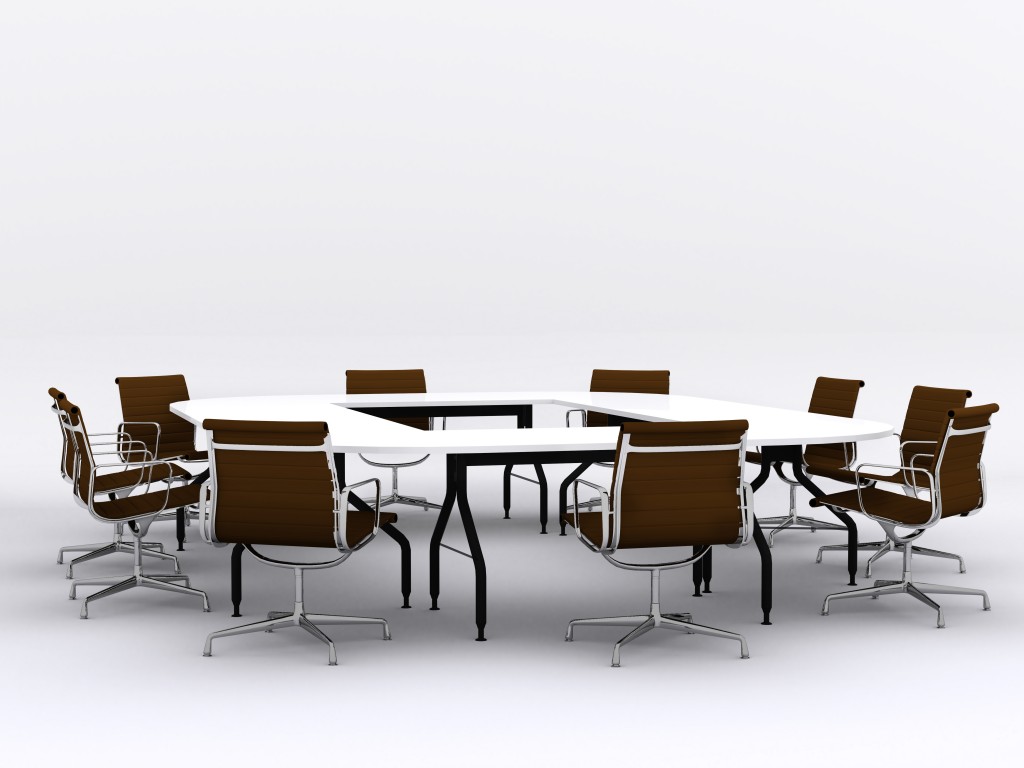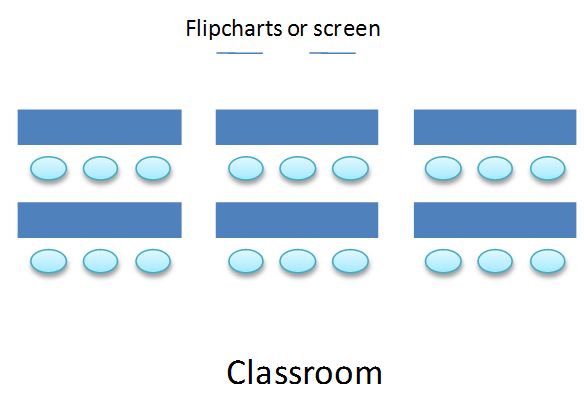These room layout tips can mean the difference between a functional and dysfunctional seminar. These tips are part of the Presentation Mastery manual.

So you’re running a training program, an offsite or a seminar. The hotel calls to ask what room layout you want. Here are some ideas to consider before you answer that question.
Room layout is like a film set: every detail counts
A room is like a film-set: every detail counts. Decide what you want and set the room up to help you get it. When setting up a room you need to take into account:
- What impression you want to create as the participants walk in (want them to think of school or uni, create the rapport of the familiar, a message that this will be different?)
- How they will be working (in groups or pairs, independently, away from desks, standing or sitting?)
The effect of room set up on people’s minds (their presuppositions, their expectations) is psycho-geography. You can use it to your advantage when you take it into account. Remember that the room, like everything else, is an anchor. You can trigger it to serve your purpose.
Where is the focus?
Where is the focus of the room? Where will you train or facilitate from? It is often most effective to have the trainer on the longest wall, rather than the shortest wall – this puts the audience closer in connection with you. If you are using flipcharts, set them up behind the place where you will be standing most of the time. If you are using PowerPoint slides make sure that you stand in a place where you are in the light: You are the singer, the PowerPoint is the song. People need to see AND hear you. Make sure you, the trainer or facilitator is the centre of focus (not a computer or a desk).
Light matters

Some trainers and facilitators prefer to close out weather and light, so that participants can more easily suspend time, (much like in a casino). If you are doing this, also hide any clocks. Other trainers and facilitators prefer natural light – make sure you make a conscious decision about which you prefer and use it to your advantage. If you use PowerPoint avoid dimming the lights – this is a signal to the human mind to get sleepy. Keep lights at a maximum until you need to use the PowerPoint – and even then dim as few as you can.
Make it nice
As far as possible, make the room look symmetrical, clean and pristine. The more it’s a “nice” learning environment (within budget), the better. If you are following on from someone else’s session and you want to refer back to material from that day, or if you’d like people to retain and use information from previous sessions consider flip charts or posters with previous material around the room. As long as the words are large enough to read from the desks, the material can be absorbed unconsciously
Seating matters
Seating arrangements will change based on the activities you expect the group to do, the size of your room, the style of people you are working with and what you are trying to achieve. The more you want rapport, the more you’ll want to begin with what they expect, what they have always had. If you want to break old patterns, consider changing the room around, removing desks, removing chairs or something else (no PowerPoint, for example, can be a major change). Here are the different layouts most venues will offer; try mixing them around to meet your objectives.

Theatre style
- No desks, can be difficult for some people to take notes
- avoid putting a central row if you can, it can split the energy, plus it can be distracting to have people moving up and down the centre of the room
- make rows short enough to get out, and leave leg room for handbags etc
- breaks the “classroom” feel
- fits more people in a room
- works well for paired / individual work, but doesn’t encourage group work
- difficult for you to maneouvre between the audience to deal with individual questions

Café / Cabaret style
- gives people desks (to take notes, to feel safer behind)
- encourages group work
- takes up a lot more space than theatre
- allows you to move easily between tables to deal with individual questions or to “eavesdrop”
- breaks the traditional “classroom” feel

U-shape
- U-shape has become the “traditional” workplace training shape now
- Can continue old “classroom” anchors
- You can try different things within the U, for example, putting people on both sides of the U, to break the old anchors, and to encourage small group / paired sharing
- People have desks, so they can take notes and they can feel safer behind them
- Makes trainer mobility easier; but many trainers find themselves boxed into the U
- Make sure the U isn’t too skinny to interact in, or the corridor between the U too long (you can feel like you’re on a catwalk!)

Classroom
- Can bring back old anchors of school (which can be good OR bad)
- People expect to be “taught” in this format
- Can be difficult for trainer to access individuals
- Works for small group, paired or individual work, but focus is towards the trainer always
- Try breaking the anchor by getting people to work with someone behind or in front of them, by changing seats midway through or between sessions

Other styles – make it up yourself!
Again, depending on your outcome, you can change the room to assist this.
- An interactive meeting where all have something to share can be for example done in a circle – if you need tables later, you can have them on the periphery of the room
- For highly interactive or fast work, you can get rid of the chairs altogether (there is a story about a major petrochemical company who abolished chairs in meeting rooms, and halved meeting time. Plus all the sitting research says it’s better for your health to stand for some of the day)
- If the room is big enough, you could combine theatre style with plenty of room to move chairs around and create smaller groups, or theatre style and cabaret style in the same room

And remember you can change it
And of course you do not have to keep the room set up you began with. You can change the room set up any time: as long as the tables and chairs are not too heavy, participants can help you lift and move them. If you are working in a hotel they will help you relocate. If something unexpected happens and there are fewer participants than normal, always clear the extra chairs if you can. You are never locked into a set up, you can change at breaks, at lunch, overnight and to suit certain activities. Do remember to return the set up to how it was if you are working in someone else’s conference room.
Whatever you do, just do it on purpose! Taking the time to think through how you want participants to be in the room, what activities you want to encourage (or discourage) can set you up for success.
About the Author: Cindy Tonkin facilitates corporate offsites. Clever teams solve their operational problems using Cindy as a facilitator and coach.
